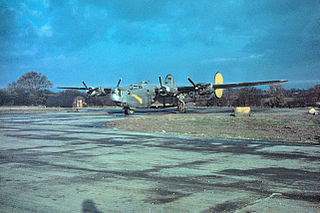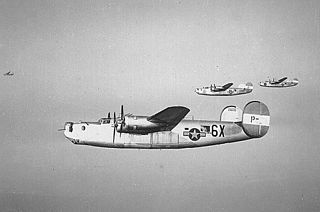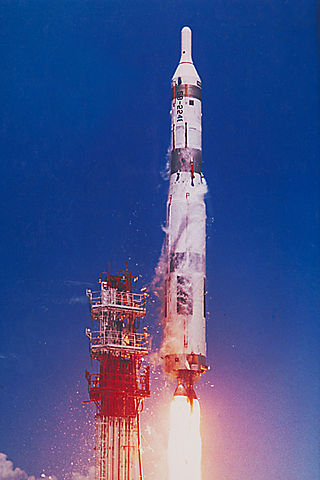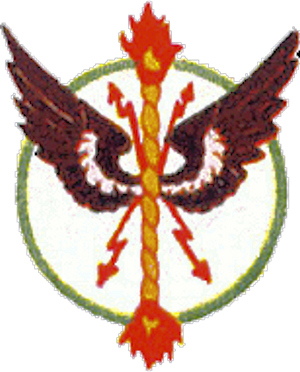
Hunter Army Airfield, located in Savannah, Georgia, United States, is a military airfield and subordinate installation to Fort Stewart located in Hinesville, Georgia.

Ramey Air Force Base also known as Borinquen Field, is a former United States Air Force base in Aguadilla, Puerto Rico. It was named after United States Army Air Forces Brigadier General Howard Knox Ramey. Following its closure, it was redeveloped into Rafael Hernandez Airport.

The 526th Intercontinental Ballistic Missile Systems Group is an inactive United States Air Force (USAF) unit. It was last located at Hill AFB, Utah, where it was inactivated in 2010. The group was first activated during World War II to conduct anti-submarine warfare in the Caribbean and off the Atlantic seaboard of Georgia and Florida. It was again active during the Cold War as an Atlas missile wing. Its final period of active service was as a systems and sustainment organization for USAF missile systems.
Vernam Field is a former World War II United States Army Air Forces airfield located in Clarendon Parish, 34.3 miles (55.2 km) west-southwest of Kingston, Jamaica. The airfield was renamed Vernam Air Force Base by the newly formed United States Air Force in 1948, but was closed in 1949.
Waller Air Force Base is a former United States Air Force World War II air base located in northeastern Trinidad. It is located about 7 km southeast of Downtown Arima south of the Churchill-Roosevelt Highway and roughly 32 km from the capital city Port of Spain.

San Antonio de los Baños Airfield is a military air base located near San Antonio de los Baños, a municipality in the province of Havana in Cuba. It is located approximately 3 mi (4.8 km) southwest of the city of San Antonio de los Baños, about 30 mi (48 km) southwest of Havana.

The 35th Bombardment Squadron is an inactive United States Air Force unit. It was activated in January 1940 as the United States built up its armed forces prior to World War II. In the fall of 1941, it deployed to the Caribbean and, following the attack on Pearl Harbor engaged in antisubmarine patrols. Following the transfer of the land based antisubmarine mission to the Navy, and with the lessening of threats to the Panama Canal, the squadron returned to the United States, where it was disbanded in June 1944.

The 2d Antisubmarine Squadron is an inactive United States Air Force unit. Its last assignment was with the 480th Antisubmarine Group, based at Clovis Army Airfield, New Mexico, and under the command of Col. Jack Roberts. On 13 November 1943, the 2d Antisubmarine Squadron was directed to relinquish their assignment to the U.S. Navy and to return to the United States with all personnel and equipment. For its role in the war, the group, which existed for only one year, was awarded a Distinguished Unit Citation, It was inactivated on 29 January 1944.

The 847th Bombardment Squadron is a former United States Army Air Forces unit that was originally activated as the 421st Bombardment Squadron. Its last assignment was with the 489th Bombardment Group at Great Bend Army Air Field, Kansas where it was inactivated on 28 March 1945. As the 20th Antisubmarine Squadron, the squadron performed antisubmarine patrols in 1942 and 1943. After reforming as a heavy bomber squadron, it engaged in the strategic bombing campaign against Germany in the European Theater of Operations until returning to the United States in late 1944. The squadron was inactivated while its parent group was training as a very heavy bombardment unit.

The 855th Bombardment Squadron is an inactive United States Air Force unit. The squadron was first activated as the 522d Bombardment Squadron at Lantana Airport, Florida, in October 1942, when it assumed the personnel and equipment of a National Guard unit engaged in antisubmarine warfare over the Atlantic. The squadron continued antisubmarine patrols as the 17th Antisubmarine Squadron until the summer of 1943, when its mission was transferred to the Navy.

The 859th Special Operations Squadron is a reserve unit of the United States Air Force. It was first activated in October 1942 as the 517th Bombardment Squadron, when the Army Air Forces replaced National Guard observation units that had been mobilized and were performing antisubmarine patrols off the Atlantic coastline. A month after its activation, the squadron was redesignated the 12th Antisubmarine Squadron. In August 1943, the Army Air forces began turning the antisubmarine patrol mission over to the Navy and the squadron moved to California, where, as the 859th Bombardment Squadron, it formed the cadre for the 492d Bombardment Group.

The 835th Bombardment Squadron is an inactive United States Army Air Forces unit. It was activated in January 1941 as the 80th Bombardment Squadron and equipped with Douglas A-20 Havoc light bombers. Following the attack on Pearl Harbor the squadron began to fly antisubmarine patrols off the Atlantic coast and over the Caribbean Sea, becoming the 9th Antisubmarine Squadron.

The 851st Strategic Missile Squadron is an inactive United States Air Force unit. It was last assigned to the 456th Strategic Aerospace Wing, stationed at Beale Air Force Base, California. It was equipped with the HGM-25A Titan I intercontinental ballistic missile, with a mission of nuclear deterrence. It was the last Titan I squadron to achieve alert status on 1 February 1961. The squadron was inactivated as part of the phaseout of the Titan I on 25 March 1965.

The 395th Tactical Missile Squadron is a United States Air Force unit. It has not been active under that name.

The 27th Bombardment Squadron is an inactive United States Air Force unit. Its last assignment was with the 30th Bombardment Group, based at Kahuku Army Airfield, Hawaii Territory. It was inactivated on 20 March 1946.

The 839th Bombardment Squadron is an inactive United States Army Air Forces unit. It was activated in January 1941 as the 79th Bombardment Squadron and equipped with Douglas A-20 Havoc light bombers. Following the attack on Pearl Harbor the squadron began to fly antisubmarine patrols off the Atlantic coast and over the Caribbean Sea, becoming the 8th Antisubmarine Squadron.

The 6th Air Defense Missile Squadron was an air defense unit of the United States Air Force. It was assigned to the New York Air Defense Sector of Aerospace Defense Command, at Suffolk County Air Force Base, New York, where it was inactivated on 15 December 1964. The squadron had its headquarters at Suffolk County Air Force Base, while the firing batteries of the squadron were at the nearby Suffolk County Air Force Base Missile Annex.

The 24th Tactical Missile Squadron is an inactive United States Air Force unit. It was last active as the 74th Air Defense Missile Squadron assigned to the 23d Air Division of Aerospace Defense Command, stationed near Duluth Municipal Airport, Minnesota, where it was inactivated in 1972. The squadron's earliest predecessor was active early in World War II as an antisubmarine unit in the Caribbean and Europe until its mission was transferred to the United States Navy. During the Cold War it was a training unit for Matador cruise missiles. Its most recently active predecessor was an air defense missile squadron in the northern United States from 1960 to 1972.

The Army Air Forces Antisubmarine Command was formed in the fall of 1942 to establish a single command to control antisubmarine warfare (ASW) activities of the Army Air Forces (AAF). It was formed from the resources of I Bomber Command, which had been carrying out the antisubmarine mission in the Atlantic and Caribbean since the Attack on Pearl Harbor due to the lack of long range Naval aviation in that area.

The 361st Tactical Missile Squadron is an inactive United States Air Force unit. It was formed in 1985 by the consolidation of the 1st Antisubmarine Squadron and the 661st Bombardment Squadron. However, the squadron was ever active under its new title.























